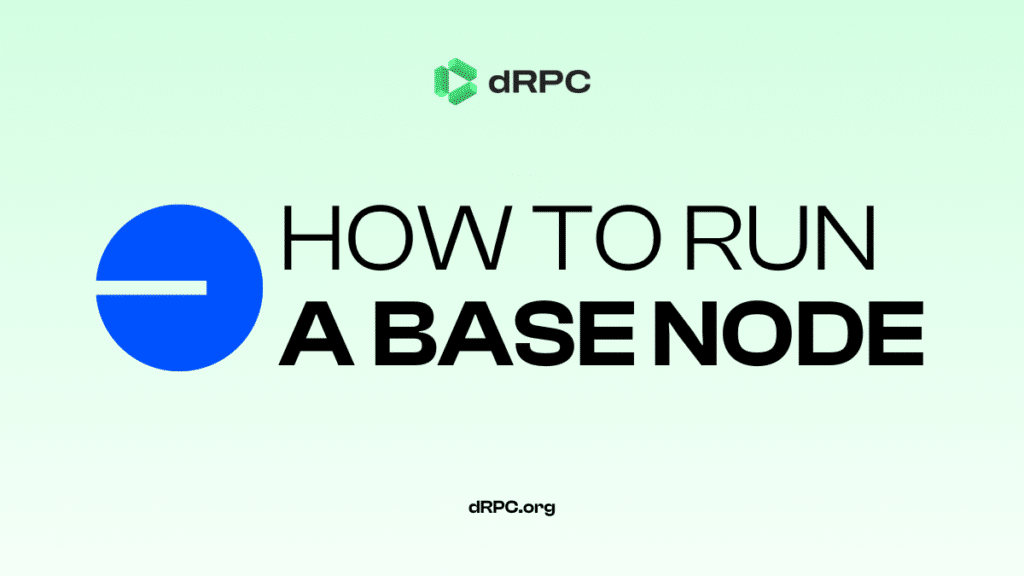Are you interested in setting up your own Base node? Running a node allows you to connect directly to the Base blockchain, giving you more control over your transactions and data. This guide provides a step-by-step approach to setting up a Base node, covering everything from hardware requirements to software installation and configuration. By the end of this guide, you’ll be ready to operate your own node and contribute to the decentralized network.
Using a third-party provider can be a great alternative for those who want to interact with the Base blockchain without managing their own infrastructure. Third-party RPC providers offer reliability, scalability, and reduced maintenance, making them ideal for developers who need consistent access to blockchain data. To explore third-party RPC solutions for Base, visit this page
Key Outcomes
Individuals setting up RPC full nodes aim to gain a deep understanding of blockchain operations. This includes deploying node services, interacting with APIs such as the Wallet API, Token API, and NFT API, and correctly configuring the RPC URL to optimize data interactions.
Progress is measured by successfully storing blockchain data, completing the initial sync, and executing terminal commands effectively. As users gain knowledge, their objectives may shift from basic node operations to advanced functionalities such as smart contract execution, privacy enhancements, and cross-chain integration.
Requirements
System Requirements
To run a Base node efficiently, ensure your system meets the following minimum specifications:
- RAM: 16GB (recommended)
- CPU: 8-core processor
- Storage: NVMe SSD with sufficient capacity for chain data and snapshot restoration
- Network: Stable high-speed internet connection
- Power Supply: Uninterrupted power source for continuous operation
- Operating System: Linux-based (Ubuntu recommended) with support for Docker
For best performance, ensure all software dependencies, such as Docker and RPC URL configurations, are properly set up. This enables seamless interaction with the blockchain while maintaining security and privacy.
Software Installation
Installing Docker
Docker is required for running the Base node in a containerized environment. To install Docker on Ubuntu, follow these steps:
sudo apt update
sudo apt install -y docker.io
sudo systemctl enable --now docker
To verify that Docker is installed, run:
docker --version
For Docker Compose, install it with:
sudo apt install docker-compose-plugin
L1 RPC URL Configuration
To configure the L1 RPC URL for your Base node:
- Edit the
.envfile and set the following parameters:
OP_NODE_L1_ETH_RPC=<Your_Ethereum_RPC_Provider_URL>
OP_NODE_L1_BEACON=<Your_Beacon_Chain_RPC_Provider_URL>
These RPC URLs can be obtained from services such as Infura, Alchemy, or Ankr. - To verify the configuration, run a test command to ensure the API is retrieving blockchain data correctly.
Node Synchronization and Snapshot Restoration
Using snapshots significantly reduces the initial sync time. Follow these steps to restore from a snapshot:
- Create a data directory:
mkdir -p ~/base-node/geth-dataIf an old directory exists, remove it before proceeding.
- Download the latest snapshot:
wget -O snapshot.tar.gz <Snapshot_URL> - Extract the snapshot:
tar -xvf snapshot.tar.gz -C ~/base-node/geth-data - Start the node using Docker Compose:
docker-compose up -d - Monitor sync progress:
docker logs -f base-node
Ensure that the latest block number matches the network’s current block height.
Node Operation
Common Synchronization Challenges
Challenges during synchronization may include:
- Slow syncing speeds: Ensure sufficient CPU and RAM resources.
- RPC request limits: Some providers limit requests; consider upgrading to a paid plan.
- Configuration errors: Check Docker logs and
.envsettings for misconfigurations.
API Interaction
For working with Web3 applications, integrate:
- Wallet API: Access blockchain wallets.
- Token API: Retrieve token balances.
- NFT API: Query NFT metadata and ownership details.
Security Considerations
To enhance security:
- Configure a firewall to allow only necessary ports (e.g.,
30303for Ethereum nodes). - Regularly update node software to prevent vulnerabilities.
- Use private RPC endpoints where possible to avoid abuse.
FAQ
What are the prerequisites for setting up a Base node?
A compatible Linux-based OS (e.g., Ubuntu), sufficient hardware (16GB RAM, NVMe SSD), and software dependencies such as Docker and RPC access.
How do I install the necessary software?
Install Docker, Docker Compose, and required blockchain dependencies. Follow the installation steps provided above.
What configuration settings should I consider?
Set up a stable network connection, ensure adequate system resources, open necessary ports, and use private RPC endpoints for enhanced security.
How can I test if my node is running correctly?
Check connectivity with commands like:
docker logs -f base-node
Verify synchronization by comparing the node’s block height with an external blockchain explorer.
What common issues might I encounter and how can I resolve them?
- Slow syncing: Increase hardware resources and use snapshots.
- RPC connection issues: Verify
.envfile settings. - Storage limitations: Ensure sufficient disk space before syncing.
Conclusion
By following this guide, you can successfully set up and operate a Base node, allowing you to interact with the blockchain directly while contributing to network decentralization. Maintaining your node ensures data integrity, enhances security, and improves blockchain accessibility for decentralized applications.


